“The Polo Lounge is like a fine old mink coat: opulent, dignified and warm.” -Bryan Miller .
Horse polo is an outdoor, ball-game, team sport that is played on a field that is the equivalent of nine American football fields, making it the largest field in organized sport. The objective of the game is easier said than done, scoring goals by knocking the small, white plastic ball into the opponent’s goals. When one throws in the complexities of being rammed by opponents, the movements and temperaments of the horse, and the bouncing of the ball itself, (among many other issues faced during the match), polo becomes a rough and hard sport that requires both precision and tactics as well as gladiatorial combativeness. Today, we’d like to introduce you to the history of the sport and the general basics such as rules, equipment & a short guide to help you get started.
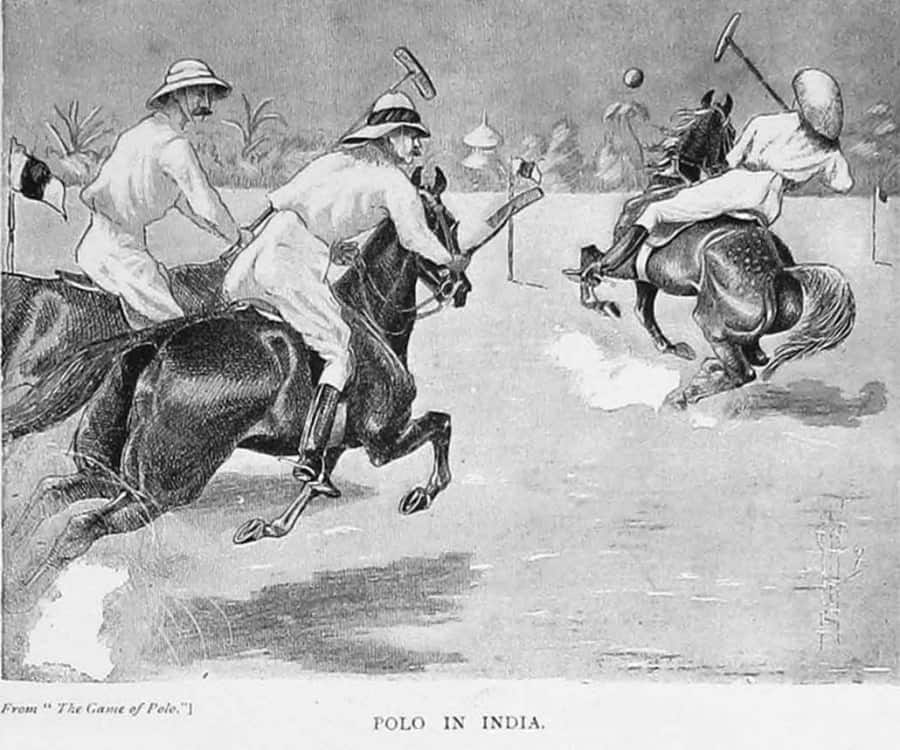
Ancient & Medieval Origins
The origins of polo stretch back over two millennia to Persia, making it one of the most ancient sports in the world but due to vague records much of the sports early history is hypothesized. The southwestern Asians originally called the game Chaugán, (also believed to be the origin of golf by some, albeit it remains unclear.)
The first known public match was said to have taken place in 600 B.C.E. where the Persian were defeated by the Turkomans. It was generally reserved for the social elite in this era, with the tribes of ancient Asia would compete through matches. In Shahnameh, the ancient poet Ferdowsi’s famous national epic, he described polo’s royal tournaments with great pomp which further emphasized polo’s aristocratic roots and its apt nickname, the “Sport of Kings” in history. A polo field along the famous silk road of China, a tablet was understood to have read “Let other people play at other things. The King of Games is still the Game of Kings.” With the Mongol’s help, polo fiercely spread through both India and China, becoming the national sport of Manipur, a state beholding a large and rich tapestry of history in polo.
The sport was also used to replicate warfare. It was used in training many of the elite cavalry of the age from the Byzantine Empire to Kashmir; (much like today, where many modern military colleges for example Sandhurst, use it to the same effect.) Closely resembling battle, the earlier and more primitive versions of polo were quite rough. During the 12th century, the ruler of Constantinople, who was a great patron of the sport, literally paid an arm and a leg during a particularly crude match. Nevertheless, polo was always held in the highest regards in terms of gentlemanliness. An Iranian player of the 9th century plainly yet eloquently stated that, “a player should strictly avoid using strong language and should be patient and temperate.”
Legend has it that polo wasn’t played with a ball, but with the chopped off heads of the captured enemies as symbol of victory. Why chopped off, you might ask? Well, leaving the rest of the body attached to the head would make the game rather cumbersome, wouldn’t it?
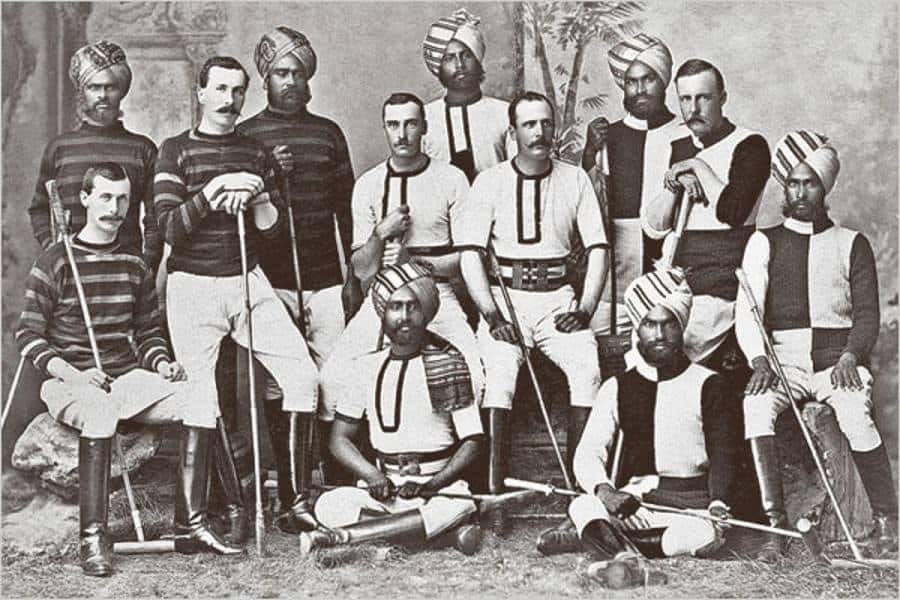
The Colonial Polo Play
After flourishing in Asia for centuries, due to the social change in the sixteenth Century polo faced a precipitous, nearly disappearing from Persia and Afghanistan among other places. However, polo did manage to survive in small pockets of the Indian frontier, like Bhutan. Around this time, the British Raj continued to expand and many government officials, like the imperial civil servants and others like indigo farmers set up in Silchar, (on the border of Burma). The Englishmen often watched the aforementioned Manipuri play their sport and soon they joined in. By the 1850s there was enough British interest to form teams. Having many previous names like tzykanion, (as used by the Byzantines) the present name was finally established, being anglicized from the Tibetan word pulu, meaning ball.
They established the Calcutta club, the first (formal) club in the world, a year after the Indian Rebellion of 1857. It is commonly accepted that the cavalry brought back the Sport of Kings to England, though there are contemporary accounts that beg to differ. It was put forth by recent speculators that it was possibly brought back by the works of Colonel T.A. St Quintin, a great sportsman of his era. His sporting journal, Chances of Sports of Sorts is considered to be how polo began in England. He later recanted the first polo match in England:
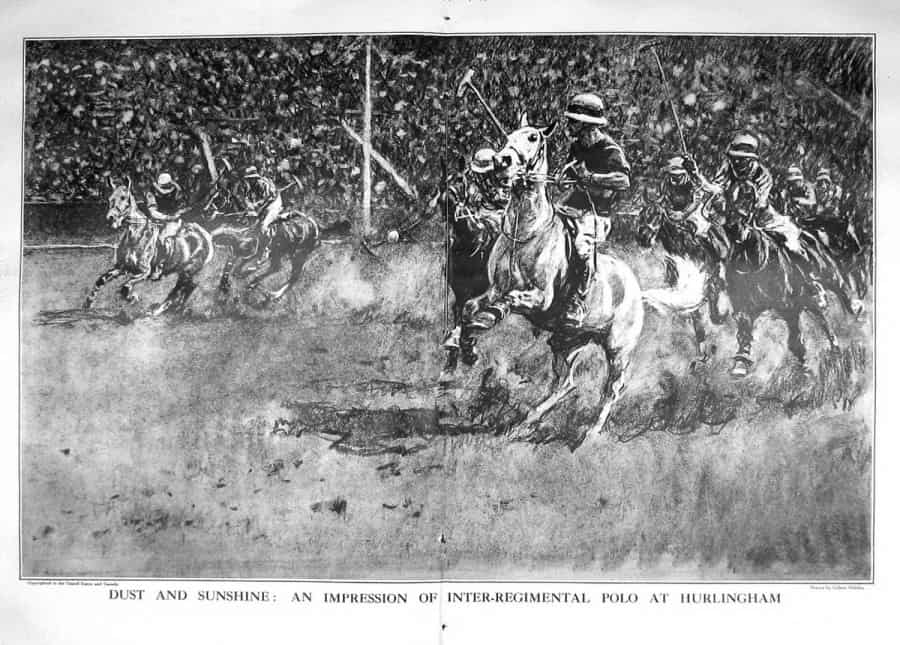
“We tried to put some sort of organization into the game, which we rather based on that of a football team…but, as you may imagine, in about two minutes the two sides were mingled up anywhere, all jammed together, ramming to each other, generally at a walk, with little idea as to where the ball was, like a football scrimmage, and the only two people remaining in their paces were the two goalkeepers, sticking religiously to their respective posts.”
Not long after, in 1874 the rules of polo were formally refined and put in place (by the governing body, Hurlingham Polo Association). The game had now taken a new character that resembles the today’s games. Drill, horsemanship, ball skills, and other qualities were developed at this time where team skills were becoming ever valued. Now polo itself had become an educational curriculum. With the rapid adoption of British cavalry regiments, the game became severely disciplined with officers sacrificing scoring for defense and tactics, a game ending in a draw was often considered a great feat in terms of strategic precision.
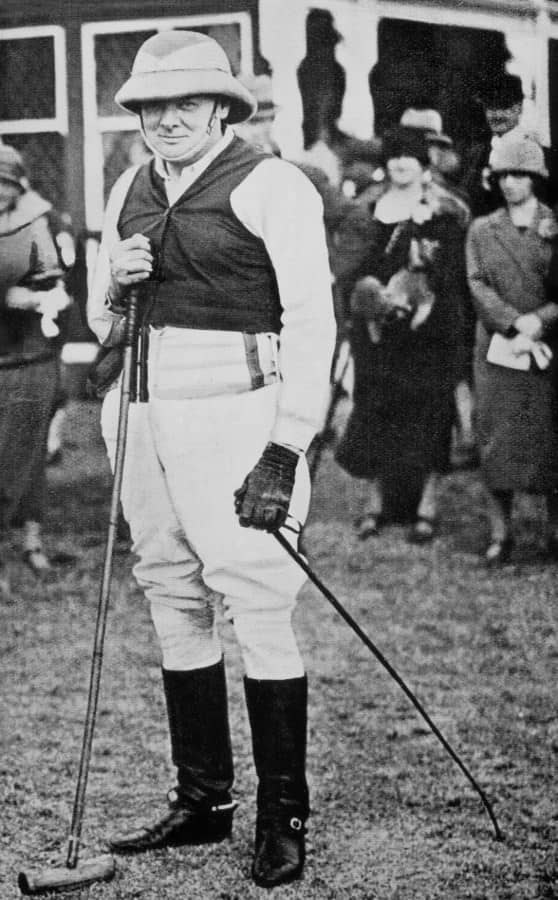
Winston Churchill Played Polo
Among many of the famous players we know today, Sir Winston Churchill, the former PM, reigned supreme as a most revered and formidable foe on the field. He picked up polo in India soon after his commission in the 4th Queens Own Hussars (1895 – 1899) and was an avid polo player until his retirement in 1927 at the generous age of fifty-two. He was a relentless player and often sought to play a minimum of eight chukkas (periods) daily, which was an extremely tiring amount, when one considers the average amount played during a game is four. His devout and pious love of polo endured through all his accidents he attained during his service in India. Upon his disembarkation, whilst attempting to set foot on the docks, Churchill slipped off and severely dislocated his shoulder because of the heavy swells rocking the steamship. Said injury perpetuated through his entire life, said to have occasionally made reading painful. One would imagine this mishap would have put a premature end to his polo career but instead he had his arm strapped to his waist during matches, enabling him to do all but make large swings. A second incident occurred during his supervision of a rifle-range where shrapnel from a nearby target gouged his thumb. Owing to the pain of the injury, daily routines such as combing hair were made excruciating, though this didn’t deter Winston, as he had taken it upon himself to strap the reins to his hand in order to play, (an extremely dangerous move in the case of emergency dismounting).
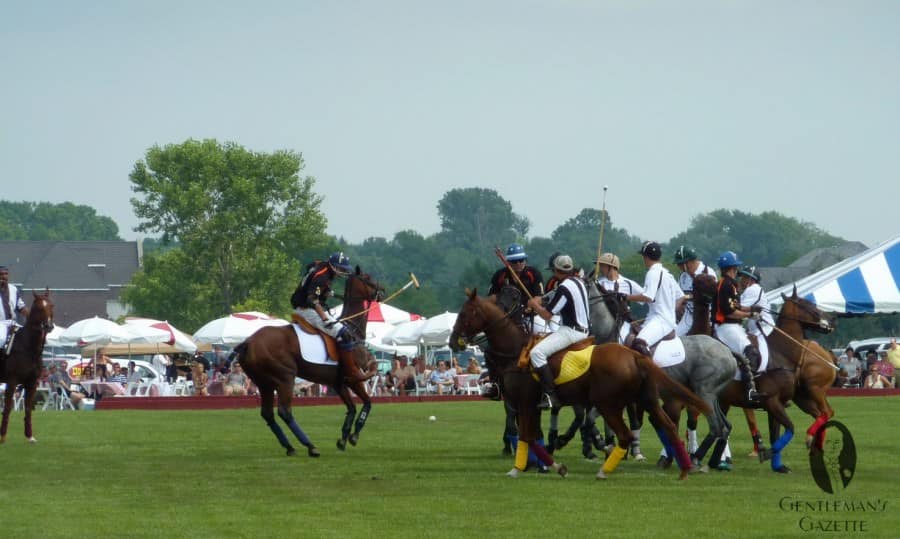
Modern Polo Sport
Now officially played by seventy-seven countries and sixteen professionally, the sport of polo has spread the world over, from not-so-humble beginnings. It attracts many viewers and sparks intrigue into those that watch. Today it is now played by both lord and farmer alike, having patrons ranging from celebrities like Tommy Lee Jones, to the Crown and its successors.
Below, find a insightful video about Polo including insights to breeding polos as well as the world’s most famous player Nacho Figueras.

It’s quite plain that the bonds between polo and the military still run very deep. A personal friend, Capt. S.S. Cobb 17/21 Ret. can attest to such. During his tenure in the 1970s with the 17/21 lancers of the British Army, he played polo across the western world. From West Germany to Ireland, polo in his regiment was nearly an institution of itself, with its history (before amalgamation) stretching to about 1895. While nearly half of his pay went towards the officer’s mess and another half went to the stabling, the Captain was usually only left with about £10 extra a month, but in his words, “What else did I need?” When one considers that his regiment literally played in the dust in Cyprus, one can clearly see the vehement and fervent dedication to the sport.
From 1900 to 1936, polo was an Olympic sport, being competed in five Olympiads, until it was discontinued from the Olympic program after the Berlin summer games. During that period, nine nations took part: Great Britain, Argentina, United States, Spain, Mexico and France, with Belgium, Germany and Hungary also competing but failing to win any medals. Recently, there were calls to reinstate polo as an Olympic sport at the 2012 London games, however the attempt was largely unsuccessful.
In the modern era of polo, Argentina dominates the world as a leading power. British settlers in the 1870s onward brought polo to the gaucho’s pampas, which swiftly took the country after the first few clubs opened. Argentina is now the de facto Mecca of polo, with the largest amount of 10-goal (highest attainable handicap) players hailing from the country.
Conclusion
Polo is a an old and traditional sport, that is very close to its roots, from honoring the cavalry that brought polo to the western world by means of wearing white jeans (or Jodhpurs), to the divot stomping at halftime. In both Constantinople’s ancient fields and those of the present Calgary polo club, a uniting factor is the love and passion for the sport that has auspiciously endured the test of time.
The Basic Rules of Polo
Usually, a polo match is divided into 4 to 6 periods called chukkers (or chukkas). Each of these is 7.5 minutes long and at 7 minutes you will hear a warning bell before the final bell rings once more at the end of each chukker. However, if a team scores after the 7 minutes warning bell or if the ball touches the sideboards of the polo field, the chukker ends immediately. Since a chukker is rather tiring for the horses, the players have 4 minutes between the chukkers to switch horses. On a very hot day, some players may even change their horses during active play, often seen jumping straight from saddle to saddle without dismounting. If there is an equal amount of goals at the end of the chukkers, there is an overtime (for as many extra chukkers as it takes) in which it becomes a sudden death game.
The Polo Players & Handicaps
Each outdoor polo team consists of four players numbered 1, 2, 3, 4. Conversely, arena polo is only played with 3 players per team but in this article we have focused on outdoor polo exclusively.
No 1 is generally the offensive player while No 4 plays defense. Players No 2 and 3 are often the most experienced players. No 3 is usually the field captain who delegates the ball, and No 2 is supposed push the play in the offense as well as the defense. None of them act as a permanent goal keeper. With only 4 players per team, each player should cover numerical opponent on the polo field. More so than in many other sports, many players only reach their peak after years of competitive play.
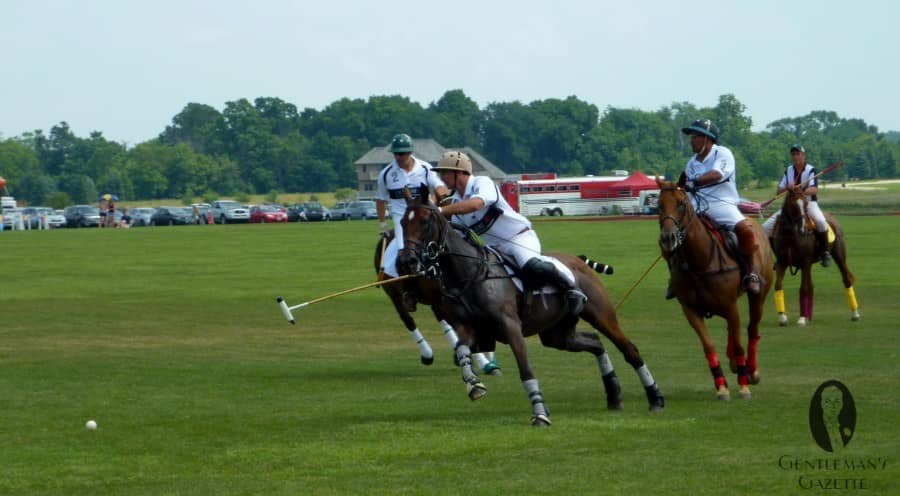
Polo Handicaps
Sir Winston Churchill once stated: “A polo handicap is your passport to the world.” Considering that polo is played all around the globe and it is not uncommon for top players to travel with their horses to different countries, he was certainly right.
The polo handicap was invented by Henry Lloyd Herbert, the first president of the US Polo Association, in 1890. The idea behind this rating system was to match teams more evenly when pairing players of varying skill levels. A player’s handicap is determined by a number of factors like sportsmanship, team play, scoring, knowledge of polo, strategy and horsemanship.
Players are rated from minus 2, representing the most novice player, to 10, representing the best player. While about two thirds of all ranked players worldwide have a handicap of 2 or below, only about a dozen players are ranked with a handicap of ten. A handicap of 5 is usually only achieved by professional players. Moreover, the ranking in Argentina – the nation that has repeatedly produced many of the world’s best polo players – can be slightly different than rankings in the US, for example.
In any case, each team’s handicap is the sum of the individuals’ handicaps; a team composed of 4 players with a handicap of 2 each would have a team handicap of 8, also referred to as an 8-goal team. In a handicap tournament, points are given to the lower rated team before the game even starts based on the difference of handicaps between the two teams. Let’s say, the team with the 8-goal team plays a team with a 10-goal team, then the 8-goal team will get a 2 point head start.
However, open tournaments where teams play “on the flat,” indicating that the handicap of the teams do not matter with regard to scoring, each game starts at 0-0.
The Polo Field
In the US, a polo field is usually 200 yards wide by 300 yards long and the goals are 8 yards wide.
In order to score a point, a player must hit the plastic ball between the goal posts – it does not matter how high or low the ball is. Interestingly, after each goal, the game is resumed from the middle but the teams switch directions and aim for the opposite goal.
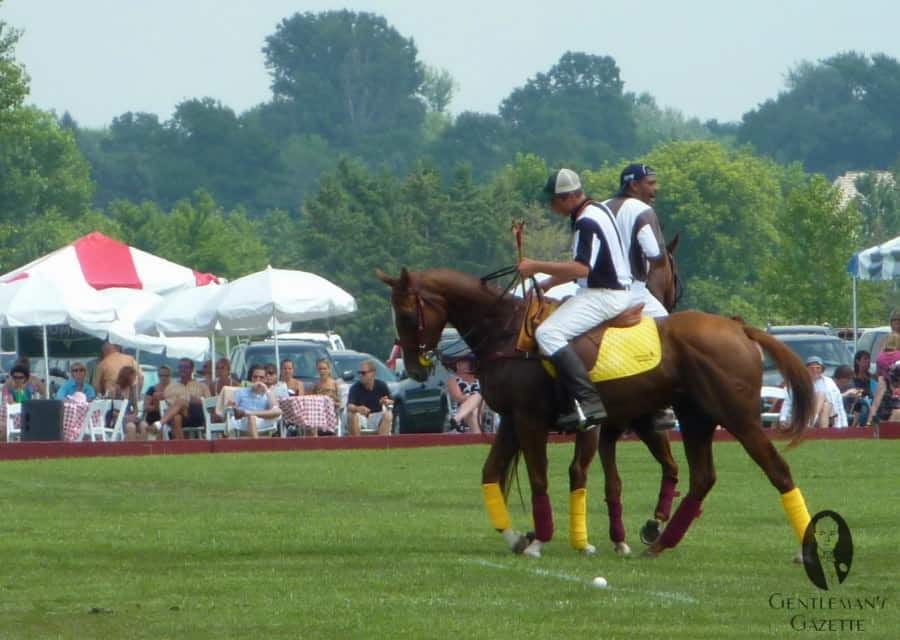
To ensure fair play, two mounted referees – to so-called umpires – are on the field as well, and a “third man” is located near the middle of the polo field to make decisions in case an umpire made a questionable call. Once a foul occurs, the umpire blows the whistle, which stops the clock.
There are several lines on the field indicating where midfield, 60, 40and 30 yard penalties are taken from.
Polo Ponies
The horses are traditionally called ponies. Most of the time, they come from the race track and have to be trained subsequently to perform in a polo game. Many of the polo ponies are faster on short distances than race horses! Apart from that, polo ponies must be very agile and they are naturally the most essential part of the polo game.
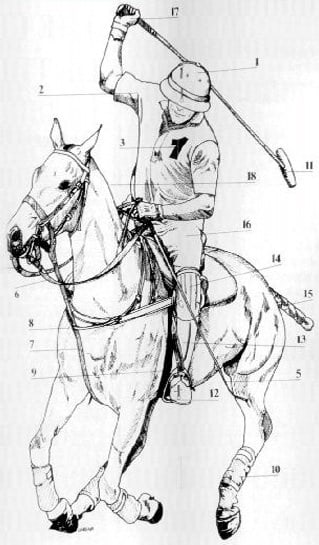
Polo Equipment
Besides the players and the horses, there is a number of gear that you will see at a polo match.
- HELMET internally padded and sometimes with a face guard
- SHIRT Polo Shirt
- NUMBER
- REINS for better control of the pony
- WHIP
- BIT Control of pony
- MARTINGALE Prevents the pony from raising its head too high and hence protects the polo player
- BREASTPLATE keeps saddle in place
- GIRTH keeps the saddle and the polo player in the correct position
- BANDAGES to protect the pony’s legs
- MALLET measures 48 to 54 inches in length; depends on pony height and reach of the player. Commonly made of bamboo and sometimes ashwood or maple. Ideally the ball is hit in the middle of the wide part
- STIRRUP for the players feet
- BOOTS brown or black almost knee high, with raised heels and often a zipper in the middle
- KNEE GUARDS
- PONY’S TAIL must always be braided
- BREECHES strictly white – often times players just wear white jeans
- GLOVES improves grip and protects hands
- MANE shaved or roached to not interfere
Fouls
Generally, it is not very easy to spot a foul. Even for professional polo players, it can be very difficult to whether a foul has been committed or not. Although there is a 53 page polo rule book in the US, I will try to share it in a nutshell.
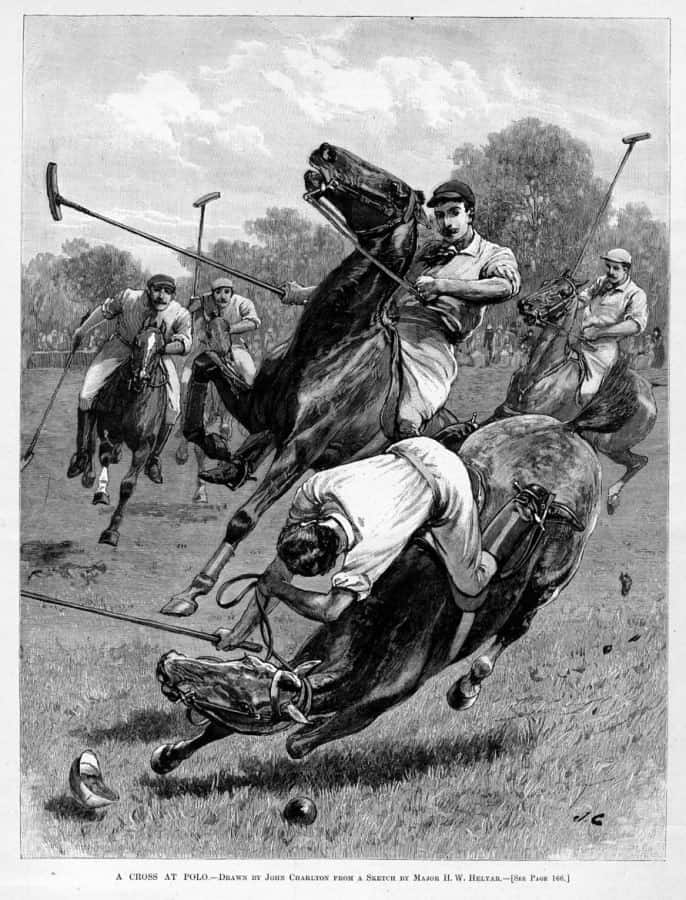
Basically, a foul occurs if there is dangerous play. The play is dangerous when a player crosses in front of the player with the ball. Hence you should think about it this way: when the polo ball is hit, it creates an imaginary line and the polo players have to follow it. With each hit, the direction of the ball changes and so does the imaginary line.
As a consequence of a foul, a penalty shot is awarded depending on where the foul was committed, or how severe it was. If the ball is hit past the back line by a defending player, a sixty-yard shot facing the spot where the ball went across the line is awarded.
The Divot Stomp – A Polo Tradition
The Divot Stomp is probably the most widely recognized tradition associated with polo.
During half-time, spectators are invited to go onto the field in order to both socialize and stomp the divots which were created during the game by the horses’ hooves.
With the basics of polo in mind, you may very well be interested in becoming a polo spectator or maybe even at a polo player, just go to the website of the United States Polo Association and look for the nearest club. Outside the US, most countries do have a national polo association which will most likely be able to direct you to a club in your area.
How you can play Polo today
In stark contrast with it’s augustly pompous past, polo today is a very accessible and open sport; welcoming those from all walks of life. Before considering joining polo, it is a prudent idea to have basic riding experience, (despite my first day on a horse was also my first time practicing). Your local club will generally start you off in private or group lessons which will inevitably lead you to trying your hand at coaching league (a slower run for beginners and novices of the sport). To give one an idea of how much it costs to start out in polo, you can check out an orthodox example of fees on Indio, CA’s famous Empire Polo Club website. Generally a day of coaching league can run from anywhere between $80 and $120, although paying by the chukka and month are common alternatives in some clubs. There’s no need to rush out to buy a horse either – leasing and renting options are typically available straight from your club. Last but not least, if you ever find yourself in Florida, you may want to stop by at the Polo Museum and Hall of Fame.
How did you like this piece? Would you like to learn more about Polo? Please answer below in the comments, thank you.

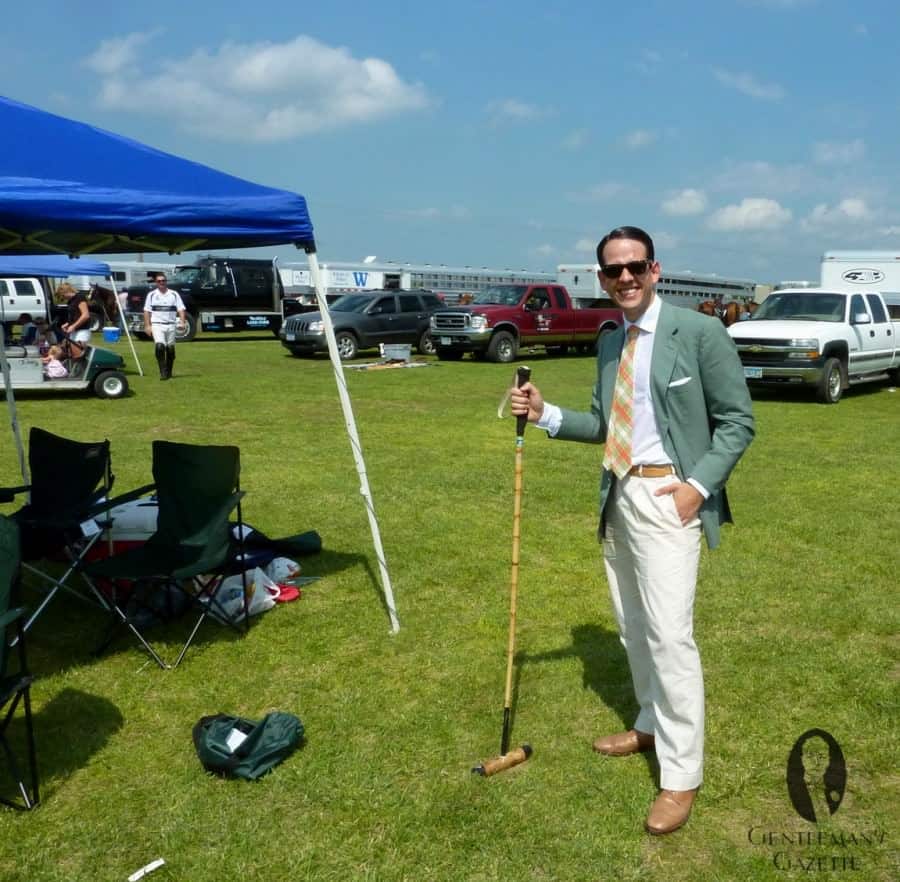
Very insightful. A nice, concise, understandable description. Now do one on cricket!
I have to find a cricket expert first! Do you know anybody?
After reading your concise article on polo, I just saw that you need a cricket expert! I have the man for you, if you don’t mind calling someone in Ireland. His name is Sir Lingard Goulding, and he undoubtedly an expert on cricket.
Interesting article.
But one rather macabre detail is forgotten. In the old times polo was not played with a ball, but with the chopped off heads of the captured enemies. Why chopped off, you would ask? Well, leaving the rest of the body attached to the head would make the game rather cumbersome
Anyway, as a retired Forensic Pathologist I thought it right to point to this minor and of course totally neglectible historical detail.
But you have to admit, it has a certain old fashioned chique: playing polo with the head of your enemy. Good old days!
Thank you for pointing that out, it is indeed an important detail!
Thank you for such an in depth article on this brilliant sport. I used to exhibit occasionally at Cowdray Park where I was fortunate to watch some high goal players – truly staggering to watch.
You are welcome Tim.
Interesting article.
One question regarding the rules. What happens when a game ends in a draw or is a draw not an option?
Btw., the 1936 Olympics were held in Berlin, not Munich. That was in 1972.
You’re right on the Berlin note, a small mistake, thanks. It is correct now and I also added a sentence about a draw, thanks for pointing that out.
It used to be a fairly stylish game, but polo pretty definitively jumped the shark in the 1980s, due to many of the players and most of the fans. More’s the shame, since it’s an exciting game and has great accouterments.
What exactly was different then – can you elaborate?
Enjoyable and well reseached, as one would have expected. I was introduced to the game in the mid ’90’s by my very dear polo-devoted friend Mr. Hasan Jafar Khan, who carries forward his ancestral distinction of excellent playing skills, with thorough knowledge and understanding. While I have never played myself but have followed the game since being a most entertaining spectator sport.
Pakistan / sub-continent has a rich history of polo, since the founding Mughal emperor Babar was a polo player himself. So was his grandson Akbar, who invented night-polo under torch lights and as per some accounts played with polo balls set on fire, made from special woods. Interestingly his Queen Nur Jehan herself was a polo player. One of the emperors Sultan Qutbuddin Aibak died as he fell from his horse during a game. The main field at the Lahore Polo Club – one of the oldest in the world – is thus named ‘Aibak Ground’ in reverence.
Another distinguishing factor is the annual ‘Shandur Polo Cup’ played at the highest polo field – in terms of altitude – in the world. And the game is played in its near primitive competitve, no-holds barred form.
As for a piece on cricket, you may look no further …
And while this may not account for much distinction, I am a non-playing member of the my native city’s Rawalpindi Polo Club
Thanks for the additional information – it is always much appreciated. As for the piece on cricket, I think that’s great idea. I think Devon knows a thing or two about Cricket as well but I think all of us together can create a great piece.
Excellent article…
Most enjoyable article! Thanks especially for the info about the Divot Stomp. I have a very minor point of clarification. Churchill did not serve in the 4th Queen’s Own Oxfordshire Hussars – no one did – they don’t exist. He served in a regular army regiment; the 4th Queens Own Hussars (1895 – 1899) and then in the Queens Own Oxfordshire Hussars (1902 – 1916) which was what Americans would call a reserve unit. The error in titles of the regiments is that little “4th” notation you added. I quickly concede again – a small error, but to us in the senior generation of military historians, it makes a difference. Winston Churchill’s only son also served in the 4th Queens Own Hussars, but like his dad, did not spend a lot of time actually with the regiment. Randolph Churchill got himself seconded to the Special Air Service during WWII and had some quite hair raising adventures, accompanied on some by a literary chap . . . Evelyn Waugh!
Thank you for pointing that out Carl. It now stands corrected.
Shop for Authentic nfl Jerseys from china best factory with the wholesale price and fast free shipping.